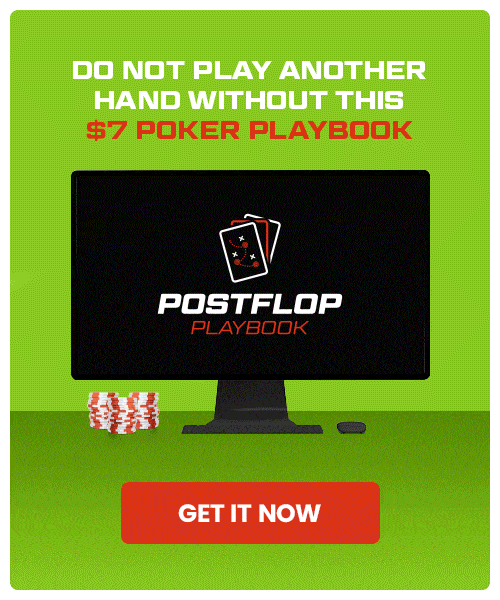How To Play Underpairs in Cash Games
It sucks when your pocket pair misses the flop, especially when you’re looking at three overcards.
But you shouldn’t always just check and fold with an underpair. Playing underpairs optimally can help you make more money in the long run. Even though they are pretty weak hands, playing them wrong will cost you expected value continuously.
To help you play them better, in this article I am going to explain to you how to play underpairs in cash games both as the preflop raiser and as the preflop caller.
Before teaching you how to play these hands, let’s make sure we’re all on the same page.
What Is An Underpair?
An underpair is a pocket pair below the lowest card on the flop.
For example:
- On a K♦ J♥ 6♣ flop, the underpairs are 22, 33, 44, and 55.
- On a Q♠ 9♠ 8♥ flop, the underpairs are 22, 33, 44, 55, 66, and 77.
Playing Underpairs as the Preflop Raiser
Playing as the preflop raiser comes with some perks. You will almost always have the range advantage, which will help you better realize the equity of your entire range, including the equity of your underpairs.
In short, you get to play more aggressively with all your hands, which includes your underpairs.
I’m going to explain how to play underpairs in two very common spots:
- When you have raised from the Lojack through Button and the Big Blind calls.
- When you 3-bet from the Small Blind against the Button or the Cutoff.
Let’s talk about them one by one.
Playing as the Preflop Raiser in Single Raised Pots
Let’s divide all flops into three groups flops and then talk about how to play underpairs on each of them:
- Double broadway (ex: K♣ Q♦ 7♠)
- Single broadway (ex: Q♦ 8♦ 7♣)
- Low flops (ex: 9♦ 5♥ 4♣)
Double Broadway Flops
On double broadway flops, you should adapt to whether there is a flush draw on the board or not.
When there is a flush draw possible, you should c-bet with your lowest pocket pairs that also have a backdoor flush draw. These hands are great for c-betting because you will force folds from some better hands and also a lot of hands that have two overcards to your pair.
Having the backdoor flush draw is valuable for two reasons:
- Both of your set outs are clean — i.e. if you make a set on the turn, it won’t complete the flush draw.
- You block some flush draws that would have called — e.g. your opponent can’t have A♥ 2♥ when you have 2♥ 2♣.
For example, on a K♥ J♣ 6♥ flop, you will want to c-bet with 2♥ 2♣, 3♥ 3♦, 4♥ 4♠, and 5♥ 5♠ but not with 5♦ 5♣.
When there is no flush draw possible, the blocker value of the suits is equal, and thus you should c-bet with any underpair.
Single Broadway Flops
On single broadway flops, the same kind of rules apply, but to a lesser degree.
Because there are fewer underpairs on these boards, you need to tighten your criteria for betting. Thus, you should only c-bet with the lowest two underpairs, namely 22 and 33. If a flush draw is possible, then you should only do it with a backdoor flush draw for the reasons described above.
Note: The lowest underpairs tend to be good bets because they unblock the folding range as much as possible.
Low Flops
You should generally check back with underpairs on low boards. You shouldn’t bet very often on these boards in general, and there are better candidates for both value betting and bluffing.
Note: Want to make more profitable decisions at the poker table so you walk away with more money? Get Doug Polk’s $7 Postflop Playbook and learn an easy-to-use system for winning at poker. Lock your seat now!
Playing as the Preflop Raiser in 3-Bet Pots
Suppose a player raises from late position (Cutoff or Button), you 3-bet from the Small Blind, and the player calls.
Note that you won’t have a ton of underpairs in these situations because you won’t 3-bet with 22, 33 and 44 very often, if at all. But you should be 3-betting as low as 66 at least some of the time.
The idea here is simple: you will have a massive range advantage on the vast majority of flops. Not only that, you will be playing with a small stack-to-pot ratio. These two factors favor a very aggressive, small bet size strategy.
As a result, you should always c-bet with your underpairs in these situations.
Playing as the Preflop Caller in Single Raised Pots
This situation will happen mostly when you have defended from the Big Blind. This means that most of the time you will be out of position against the preflop raiser — a highly unfavorable situation.
If you check and face a bet, you will only be able to call profitably with an underpair when a few things come together:
- The raiser has a wide starting range (e.g. he’s playing from the Button).
- The board is disconnected (such as K♣ T♠ 5♦).
- You have at least a backdoor flush draw.*
*This factor is obviously only relevant when the board has a flush draw.
When all these factors come together, you can call with your underpair. Otherwise, it would be a losing decision to continue.
A Quick Test to See How Well You Understood This Article
Take a moment to consider each question, then reveal the answer when you’re ready. Assume you’re playing online and have no reads on your opponent.
Question 1: BTN vs BB Single Raised Pot: Flop is A♠ J♠ 7♣
Do you check or c-bet with 5♠ 5♣?
Question 2: BTN vs BB Single Raised Pot: Flop is K♥ 8♠ 6♣
Do you check or c-bet with 3♣ 3♦?
Question 3: BB vs BTN Single Raised Pot: Flop is K♦ T♦ 5♣
Do you check-call with 4♠ 4♥ against a 66% pot c-bet?
Question 4: BB vs BTN Single Raised Pot: Flop is J♣ T♣ 5♠:
Do you check-call with 3♣ 3♦ against 33% pot c-bet?
Question 5: SB vs BTN 3-Bet Pot: Flop is A♠ T♦ 8♣
Do you c-bet 33% pot or check with 6♦ 6♣?
Wrapping Up
If you’ve hit 5/5 then congrats, you’ve been paying attention! If not, make sure to read back and focus on that area! Playing underpairs is not very difficult once you understand the few key situations that take place.
That’s all for this article guys! I hope you enjoyed it and that you’re going to start applying this information right away! Let me know if you have any questions in the comments below.
Read this next to learn about playing another common hand class: 5 Strategic Mistakes to Avoid with Suited Connectors.
Till’ next time, good luck, grinders!
Note: Doug Polk’s poker strategy crash course (The Postflop Playbook) takes less than 2 hours to complete and costs just $7. What are you waiting for? Improve your skills before your next session.

